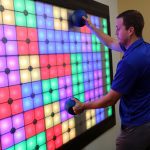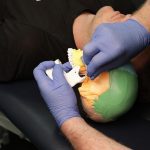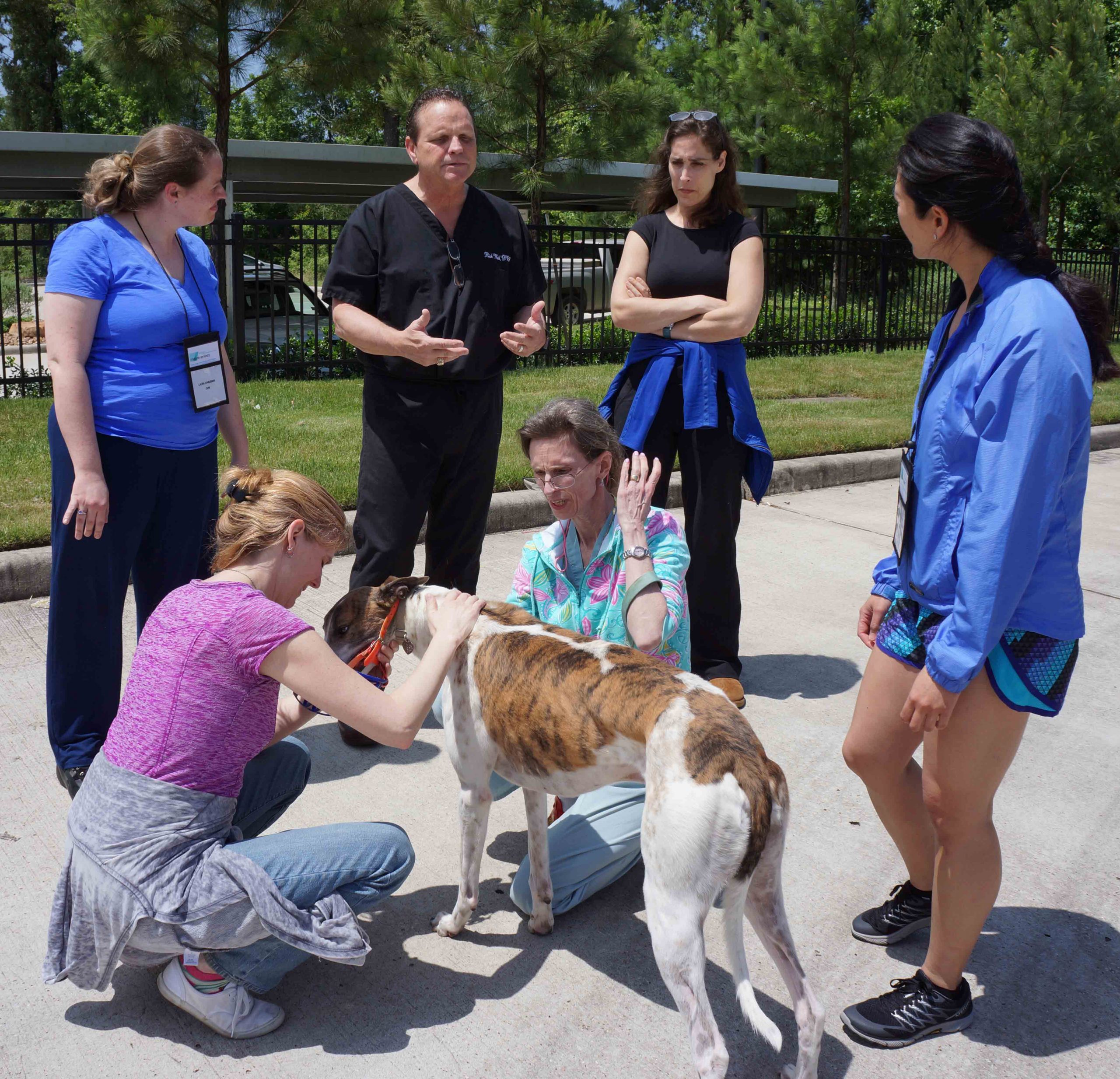On average, muscles make up about 42%-47% of total human body weight. In dogs, the percentages tend be slightly higher with up to 57% for greyhounds! Interestingly, although more than half the dog’s bodyweight consists of muscles, veterinarians do not routinely consider muscles as a peripheral source of nociception (Wall 2014). Yet, the  veterinary practitioner with an interest in pain management, rehabilitation, orthopedics, and sports medicine should be familiar with the characteristics, etiology, and precipitating factors of myofascial trigger points. Since 2012, Drs. Rick Wall and Jan Dommerholt have been teaching canine trigger point courses in The Woodlands, TX.
veterinary practitioner with an interest in pain management, rehabilitation, orthopedics, and sports medicine should be familiar with the characteristics, etiology, and precipitating factors of myofascial trigger points. Since 2012, Drs. Rick Wall and Jan Dommerholt have been teaching canine trigger point courses in The Woodlands, TX.
In this blog, we will review a few of the experiences with canine trigger point therapy.
Sadie, the Yorkshire Terrier
Physical therapists Cynthia and William Kolb published a lovely article in 2019 of their experiences with the treatment of Sadie, a Yorkshire Terrier (Kolb and Kolb 2019). Cynthia Kolb completed the Canine TrP Management course a few years ago. The 10-year-old SF Yorkshire terrier presented with left thoracic limb lameness of greater than one year. On initial assessment, the patient presented with reactive tenderness to palpation of trigger points located in the latissimus dorsi, teres major, and tricipital muscle areas. The end outcome measures demonstrated improved functional scores, improvement in gait evaluation, and a resolution of altered sensation in the left front paw. The dog had also been diagnosed with left elbow arthritis. On initial assessment, Sadie greeted the Certified Canine Rehabilitation Therapist (CCRT) on a full run with quick turns, then immediately stopped, lifting high the left front leg (LFL). On slick surfaces, Sadie gaited on 3 legs, carrying the LFL, but used all 4 legs on carpeted areas 80% of the time. In standing, she would immediately offload the LFL. The therapists noted several compensatory mechanisms and implemented a treatment regimen consisting of stretching. When Sadie did not respond favorably to stretching, trigger point dry needling was added to the treatment with the consent of the treating veterinarian.
 Multiple trigger points noted in the left latissimus/teres major area and left subscapularis that when palpated elicited a pain response from Sadie. Areas that were dry needled included the left latissimus dorsi, teres major, and triceps. Gentle coning and pistoning were used until a local twitch response was achieved. The insertion time for each was less than 10 seconds for each trigger point. Range of motion of the left latissimus dorsi was at best about 15% before DN. After needling 2 areas, the ROM improved to 75%. Sadie then allowed grade 2-3 mobilization of the radial/ulnar joint, carpals, and sesamoids. Range of motion of the left elbow after needling at 90%. Decreased tenderness noted at T4-12 after needling. Passive ROM of the left sartorius and bilateral hamstring was also performed with Sadie in sidelying.
Multiple trigger points noted in the left latissimus/teres major area and left subscapularis that when palpated elicited a pain response from Sadie. Areas that were dry needled included the left latissimus dorsi, teres major, and triceps. Gentle coning and pistoning were used until a local twitch response was achieved. The insertion time for each was less than 10 seconds for each trigger point. Range of motion of the left latissimus dorsi was at best about 15% before DN. After needling 2 areas, the ROM improved to 75%. Sadie then allowed grade 2-3 mobilization of the radial/ulnar joint, carpals, and sesamoids. Range of motion of the left elbow after needling at 90%. Decreased tenderness noted at T4-12 after needling. Passive ROM of the left sartorius and bilateral hamstring was also performed with Sadie in sidelying.
After 4 visits, the client stated “This is the best that she has been for months and months! She is running wide open outside, is jumping on and off furniture, and is not favoring that leg. She is enjoying the stretches and looks forward to it, lying down in the middle of the floor.” The clients also stated that since the last visit, Sadie had not chewed or licked on her LFL the entire week.
Ruby, the Labrador Retriever
Veterinary anesthesiologist, pain specialist, and animal welfare scientist, and former student of the Myopain Seminars Canine Dry Needling course, Dr. Alicia Karas from Cummings Veterinary Medical Center at Tufts University reported an interesting case report.
Ruby, a two-year-old female Labrador Retriever with multiple complications following a traumatic diaphragmatic hernia repair, remained three-legged lame despite rehabilitation therapies for four months when she was referred to the Pain Consultation and Referral Service at Tufts Cummings School to explore alternatives to amputation of the limb.
Upon presentation, she carried her right hind leg with the stifle near her abdomen, stood and walked with her spine bowed out to the left. Tight, abnormally firm muscle bands were palpated in her quadriceps, gluteal, and hamstring muscle groups as well as bilaterally along her entire spine and in both shoulders. These “contractured” muscles limited range of motion, preventing normal extension of her coxofemoral, stifle and hock joints. With a presumptive diagnosis of myofascial trigger points, treatment with trigger point dry needling was recommended to release the MTPs and permit normal muscle lengthening.
Immediately after needling, softening of the muscles and improvement in range of motion / extension of her stifle, hock and hip could be appreciated. After reversal of sedation, Ruby was able to drop her left stifle away from her abdomen and place her foot on the ground. She walked out of the clinic using the leg to walk about 60 % of her strides.
Her activity was changed from active Frisbee and beach running to long daily leash walks.
Eighteen months after her final treatment session, her gait abnormality is almost entirely resolved. She has some residual tarsal instability and is unable to place the heel of her left hind foot entirely on the ground due to tissue restrictions of her lower limb, but is back to playing Frisbee and medication free.
According to the owner “Ruby is doing terrific! She lets us know when she has had enough and takes her Frisbee inside with her!”
 During the Canine Trigger Point Management course, students will learn to appreciate the assessment of muscle dysfunction. Take for example Blaiz, a greyhound with lameness. Dr. Wall explains the rationale for including the evaluation of muscles into the examination. (Make sure to click on the links….)
During the Canine Trigger Point Management course, students will learn to appreciate the assessment of muscle dysfunction. Take for example Blaiz, a greyhound with lameness. Dr. Wall explains the rationale for including the evaluation of muscles into the examination. (Make sure to click on the links….)
The Camel without a Name
Some former students of the Myopain Seminars Dry Needling or Canine TrP Management courses have applied their newly learned dry needling skills to other patients. In Qatar, for example, physical therapist Yazan Alkhatib has treated camels with dry needling. When one of his human patients mentioned that one of his camels had much difficulty getting up, Yazan went out to the farm, examined the patient with the assistance of the camel’s handlers, and proceeded with dry needling of the hamstrings, quadriceps, and gluteal muscles! After the DN session, the camel was able to get up with no residual problems.
Chester
Other former students, such as Dr. Yasmin Mahmood, DVM have successfully treated cats and horses with dry needling. According to Dr. Mahmood, “Myofascial trigger points occur in dense clusters and can take several treatments to maximize the benefits of Dry Needling. The procedure is generally well-tolerated and the peak results are seen in 7-10 days post needling. If a competition or event is scheduled, it is recommended to perform Dry Needling treatment far enough in advance of the event as there is a normal soreness period post needling for 2-3 days.”
Myopain Seminars will soon add an Equine Dry Needling course to our course offerings Stay tuned!
A Cat
In the next video, Dr. Yasmin Mahmood performed trigger point dry needling on the triceps muscle of a cat with intervertebral disc disease and generalized myalgia (the cat is sedated for the procedure) – she elicited several local twitch responses. This was just one of the areas that were treated in this fantastic feline patient.
Dr. Yasmin Mahmood performing trigger point dry needling on the triceps muscle of a cat with intervertebral disc disease and generalized myalgia (cat is sedated for procedure) - elicited several local twitch responses. This was just one of the areas that were treated in this fantastic feline patient. Thank you Ty for helping make this video!
Posted by Meadow Run Veterinary Services on Thursday, October 27, 2016

Register for Our Course
Myopain Seminars’ curriculum is developed by international leaders in dry needling and manual trigger point therapy. Our courses are a great way to bring a unique and innovative treatment option to your patients. Completing our course programs elevates your practice and expands your clinician’s toolbox to encompass a wide range of therapies that can effectively eliminate patient pain.
References
Kolb, C & Kolb, W, 2019. Myofascial trigger point dry needling and manual therapy in a Yorkshire Terrier: a case report. Orthopaedic Practice, 31, 189-191.
Wall, R, 2014. Introduction to Myofascial Trigger Points in Dogs. Top Companion Anim Med, 29, 43-48.


